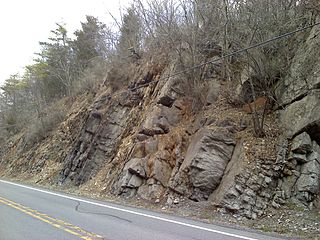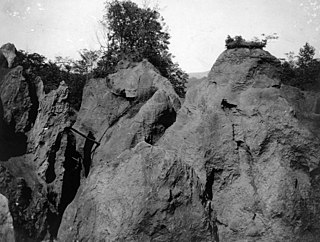The Devonian Mahantango Formation is a mapped bedrock unit in Pennsylvania, West Virginia, and Maryland. It is named for the North branch of the Mahantango Creek in Perry and Juniata counties in Pennsylvania. It is a member of the Hamilton Group, along with the underlying the Marcellus Formation Shale. South of Tuscarora Mountain in south central Pennsylvania, the lower members of this unit were also mapped as the Montebello Formation. Details of the type section and of stratigraphic nomenclature for this unit as used by the U.S. Geological Survey are available on-line at the National Geologic Map Database.

The Late Silurian to Early Devonian Keyser Formation is a mapped limestone bedrock unit in Pennsylvania, Maryland, Virginia, and West Virginia.

The Casselman Formation mapped sedimentary bedrock unit in Pennsylvania, Maryland, and West Virginia, of Pennsylvanian age. It is the uppermost of two formations in the Conemaugh Group, the lower being the Glenshaw Formation. The boundary between these two units is the top of the marine Ames Limestone. The Conemaugh Group overlies the Upper Freeport coal bed of the Allegheny Formation and underlies the Pittsburgh coal seam of the Monongahela Group.

The Glenshaw Formation is a mapped sedimentary bedrock unit in Pennsylvania, Maryland, West Virginia, and Ohio, of Pennsylvanian age. It is the lower of two formations in the Conemaugh Group, the upper being the Casselman Formation. The boundary between these two units is the top of the marine Ames Limestone. The Conemaugh Group overlies the Upper Freeport coal bed of the Allegheny Formation and underlies the Pittsburgh coal seam of the Monongahela Group.

Fossiliferous limestone is any type of limestone, made mostly of calcium carbonate (CaCO3) in the form of the minerals calcite or aragonite, that contains an abundance of fossils or fossil traces. The fossils in these rocks may be of macroscopic or microscopic size. The sort of macroscopic fossils often include crinoid stems, brachiopods, gastropods, and other hard shelled mollusk remains.
The Williamsport Sandstone is a sandstone geologic formation in West Virginia, Virginia, Pennsylvania, and Maryland. the formation includes the Cedar Creek Limestone member. Near Cumberland, Maryland it includes the Cedar Creek Limestone member. It preserves fossils dating back to the Silurian period.

The Salem Formation is a geologic formation in Illinois, Indiana, Kentucky, and Missouri. It preserves fossils dating back to the Mississippian subperiod. This formation is quarried and used as a building material, known as "Indiana limestone", also called Bedford limestone.

The Kinzers Formation is a geologic formation in Pennsylvania. It preserves fossils dating back to the Cambrian Period.

The Tomstown Dolomite or Tomstown Formation is a geologic formation in Maryland, Pennsylvania, Virginia and West Virginia. It preserves fossils dating to the Cambrian Period.
The Genesee Group is a geologic formation in Pennsylvania. It preserves fossils dating back to the Devonian period.

The Greenhorn Limestone or Greenhorn Formation is a geologic formation in the Great Plains Region of the United States, dating to the Cenomanian and Turonian ages of the Late Cretaceous period. The formation gives its name to the Greenhorn cycle of the Western Interior Seaway.
The Red Eagle Formation is a geologic formation ranging from Oklahoma, through Kansas, into southeast Nebraska of the United States. Its members define the Carboniferous-Permian boundary in Kansas.
The Grenola Formation is an early Permian geologic formation (Wolfcampian) with its exposure running north and south through Kansas and extending into Nebraska and Oklahoma, notably having the Neva Limestone member, which is a terrace-forming aquifer and historic Flint Hills building stone source secondary to the Cottonwood Limestone.
The Agua Nueva Formation is a geologic formation in Mexico. It preserves fossils dating back to the upper part of the Cenomanian stage of the Cretaceous period. It consists "predominantly of alternating fossiliferous, organic matter-rich, laminated, dark gray limestone and non-laminated, organic matter-poor limestone in decimeter-thick beds with occasional centimetric beds of brown shale that show no apparent internal structures." The formation is noted for its qualities as a Konservat-Lagerstätte, with notable finds including the plesiosaur Mauriciosaurus and shark Aquilolamna.
The Taman Formation is a geologic formation in Mexico. It preserves fossils dating back to the Jurassic period. It was deposited in a "oxic to anoxic, shallow marine environment" The lithology predominantly consists of limestone and shale.

The Korallenoolith Formation is a geologic formation in Germany. It preserves fossils dating back to the Jurassic period. It predominantly consists of oolitic limestone.
The Kössen Formation is a Late Triassic (Rhaetian-age) geological formation in the Northern Calcareous Alps of Austria and Germany, in the Tiroler-Lech Nature Park. During the Late Triassic, the area now occupied by the Northern Calcareous Alps was instead a long, passive coastline at the western tip of the Neotethys Ocean. The environment was initially dominated by a wide and shallow carbonate platform within a lagoon between the shore and a string of reefs. This carbonate platform is nowadays preserved as the Carnian to Norian-age Hauptdolomit and Dachstein Formation. The Kössen Formation represents a period of increased siliciclastic clay input into the lagoon, covering up the carbonate platform with marls and marly limestones instead of pure limestone or dolomite. The Eiberg Member of the Kössen Formation was deposited in the Eiberg basin, a narrow strip of deeper water which developed between the carbonate platform and the shoreline in the later part of the Rhaetian.
The Waynesboro Formation is a limestone, dolomite, and sandstone geologic formation in Virginia, Maryland, Pennsylvania and West Virginia. In some areas it is composed of limestone and dolomite. The Waynsboro Formation is one of the formations that make up the Shenandoah Valley. It dates back to the Cambrian period and is not considered fossiliferous.
The Huntersville Chert or Huntersville Formation is a Devonian geologic formation in the Appalachian region of the United States. It is primarily composed of mottled white, yellow, and dark grey chert, and is separated from the underlying Oriskany Sandstone by an unconformity. The Huntersville Chert is laterally equivalent to the Needmore Shale, which lies north of the New River. It is also laterally equivalent to a sandy limestone unit which is often equated with the Onondaga Limestone. These formations are placed in the Onesquethaw Stage of Appalachian chronostratigraphy, roughly equivalent to the Emsian and Eifelian stages of the broader Devonian system.









